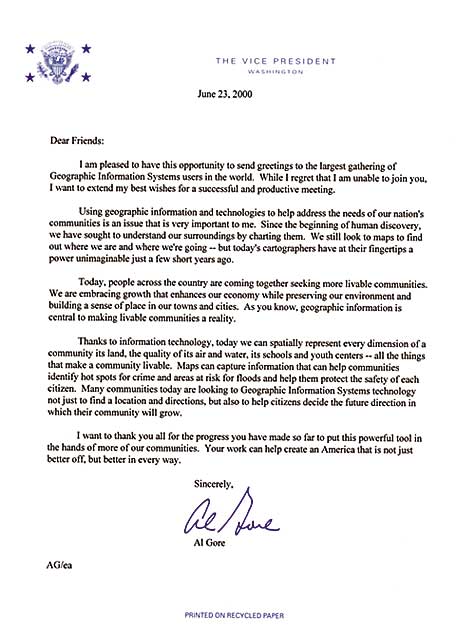



|
|
||
 |
 |
|
 |
 |
|
Vice President Gore Discusses the Digital EarthA Vision Takes Root"Digital Earth will be a virtual representation of our planet that enables a person to explore and interact with the vast amounts of natural and cultural information gathered about the Earth." (Consensus definition adopted at the second interagency workshop, September 23, 1999) In 1998 Vice President Al Gore gave a speech at the California Science Center in Los Angeles, California, describing a remarkable idea—the creation of "a multiresolution, three-dimensional representation of the planet, into which we can embed vast quantities of georeferenced data." It was this vision that Gore shared with the attendees of the Esri 2000 User Conference through a letter distributed at the conference (see letter below). In conjunction with the conference theme, "Geography�Our Global Network," Gore sees the Digital Earth as part of the answer to our world's insatiable hunger for knowledge, a way to unite the vast array of diffuse and separate data collections around the world. He envisions the possibility of a child going to a Digital Earth exhibit at a local museum and, using virtual reality technology, having the capability to zoom into and across the planet, crossing mountainous wilds and urban terrain at one-meter resolution. This same child could also interact with many other types of data, seamlessly integrated over the three-dimensional sphere. Land cover, historical information, real-time weather, and population statistics could be among the many data layers available for the child to explore. Of course, a project such as this is far beyond the reach of any one organization. The creation of the Digital Earth requires the efforts of individuals, corporations, and academia around the world. For this reason, the Geography Network is an important step in creating the types of public and private partnerships needed between data providers. When expanding on the Digital Earth's possibilities in 1998, Gore stated, "Although some of the data for the Digital Earth would be in the public domain, it might also become a digital marketplace for companies selling a vast array of commercial imagery and value-added information services. It could also become a collaboratory—a laboratory without walls—for research scientists seeking to understand the complex interaction between humanity and our environment." Although such an ambitious undertaking may seem like science fiction, much of the needed technology is already in existence or under development. For more information about the Digital Earth project, please visit www.digitalearth.gov.  |